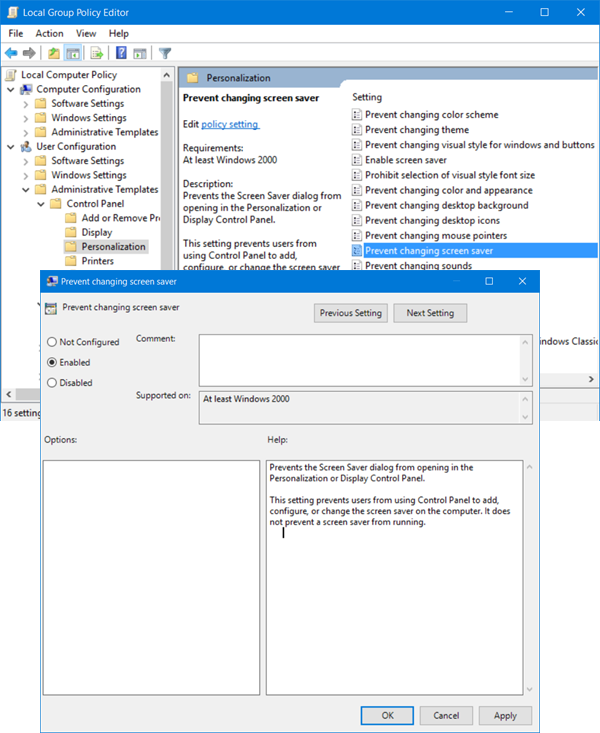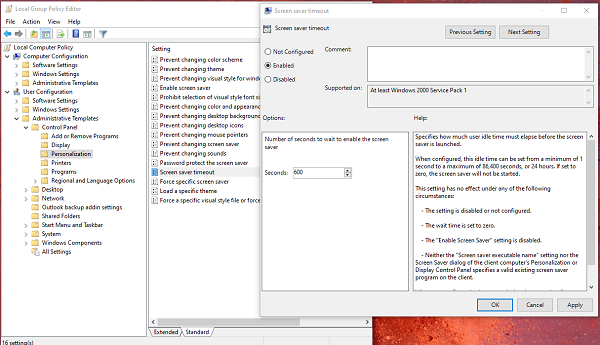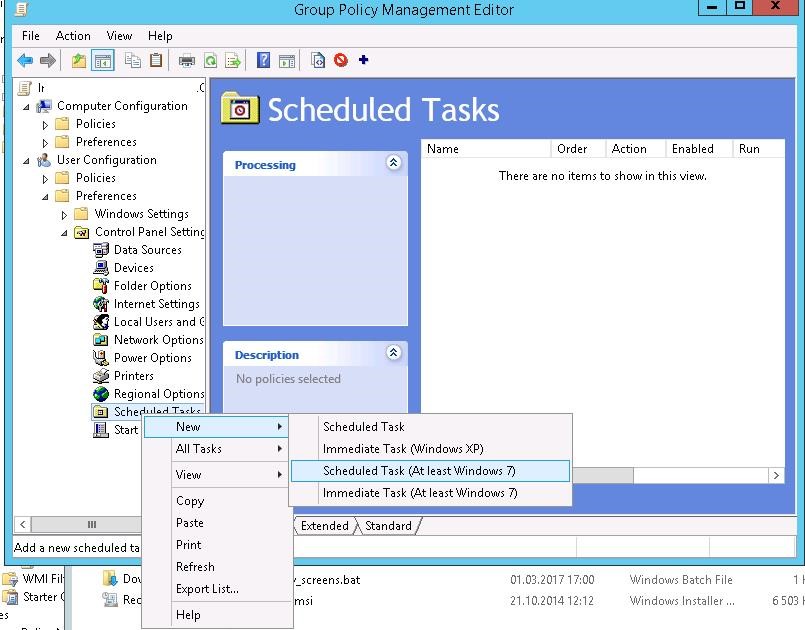

 Enable it, and then add screen timeout in seconds. Find a policy with the name “Screen saver timeout.” Double click to open it. Navigate to User Configuration > Administrative Templates> Control Panel > Personalization. Type gpedit.msc in the Run prompt, and hit Enter to open Group Policy Editor. Now in the right pane, right click empty space > New > String Value > Type ScreenSaveTimeOut > Enter.įinally right click ScreenSaveTimeOut > Modify > give it a Value Data in seconds. Next, click on the Desktop key to highlight it. Right-click on this Control Panel and again select > New > Key. Here in the right pane, right-click Windows and select > New > Key. Open regedit and navigate to the following location: Computer\HKEY_CURRENT_USER\Software\Policies\Microsoft\Windows To change the screensaver timeout setting, increase the wait time from 1 to maybe 15 or anything which works for you. Here you can change screen saver type, preview, open settings, change wait time, and choose to display lock screen on resume. You should see the Change Screen Saver option. Open Start menu, and type screen saver. Also if this solved your problem mark as answer. Surendar S if this is helpful please mark it so. In the details pane, double-click Desktop Wallpaper.Ĭurrent path to the wallpaper file is \\Shares\COMMON\Images\Wallpaper\Background.bmp Expand User Configuration, expand Administrative Templates, expand Desktop, and then click Desktop.ĥ. Right-click the GPO that you have created for the domain users, and then click Edit to open the GPO.Ĥ. Note If you have not created a GPO for the domain users, right-click Group Policy Objects, and then click New to create a GPO for the domain users.ģ. In the Group Policy Management Console, locate the Group Policy Objects folder, and then select the Group Policy object (GPO) that you have created for the domain users. Open the Group Policy Management Console.Ģ.
Enable it, and then add screen timeout in seconds. Find a policy with the name “Screen saver timeout.” Double click to open it. Navigate to User Configuration > Administrative Templates> Control Panel > Personalization. Type gpedit.msc in the Run prompt, and hit Enter to open Group Policy Editor. Now in the right pane, right click empty space > New > String Value > Type ScreenSaveTimeOut > Enter.įinally right click ScreenSaveTimeOut > Modify > give it a Value Data in seconds. Next, click on the Desktop key to highlight it. Right-click on this Control Panel and again select > New > Key. Here in the right pane, right-click Windows and select > New > Key. Open regedit and navigate to the following location: Computer\HKEY_CURRENT_USER\Software\Policies\Microsoft\Windows To change the screensaver timeout setting, increase the wait time from 1 to maybe 15 or anything which works for you. Here you can change screen saver type, preview, open settings, change wait time, and choose to display lock screen on resume. You should see the Change Screen Saver option. Open Start menu, and type screen saver. Also if this solved your problem mark as answer. Surendar S if this is helpful please mark it so. In the details pane, double-click Desktop Wallpaper.Ĭurrent path to the wallpaper file is \\Shares\COMMON\Images\Wallpaper\Background.bmp Expand User Configuration, expand Administrative Templates, expand Desktop, and then click Desktop.ĥ. Right-click the GPO that you have created for the domain users, and then click Edit to open the GPO.Ĥ. Note If you have not created a GPO for the domain users, right-click Group Policy Objects, and then click New to create a GPO for the domain users.ģ. In the Group Policy Management Console, locate the Group Policy Objects folder, and then select the Group Policy object (GPO) that you have created for the domain users. Open the Group Policy Management Console.Ģ. 
To apply a "Desktop Wallpaper" Group Policy setting, follow these steps:ġ.










